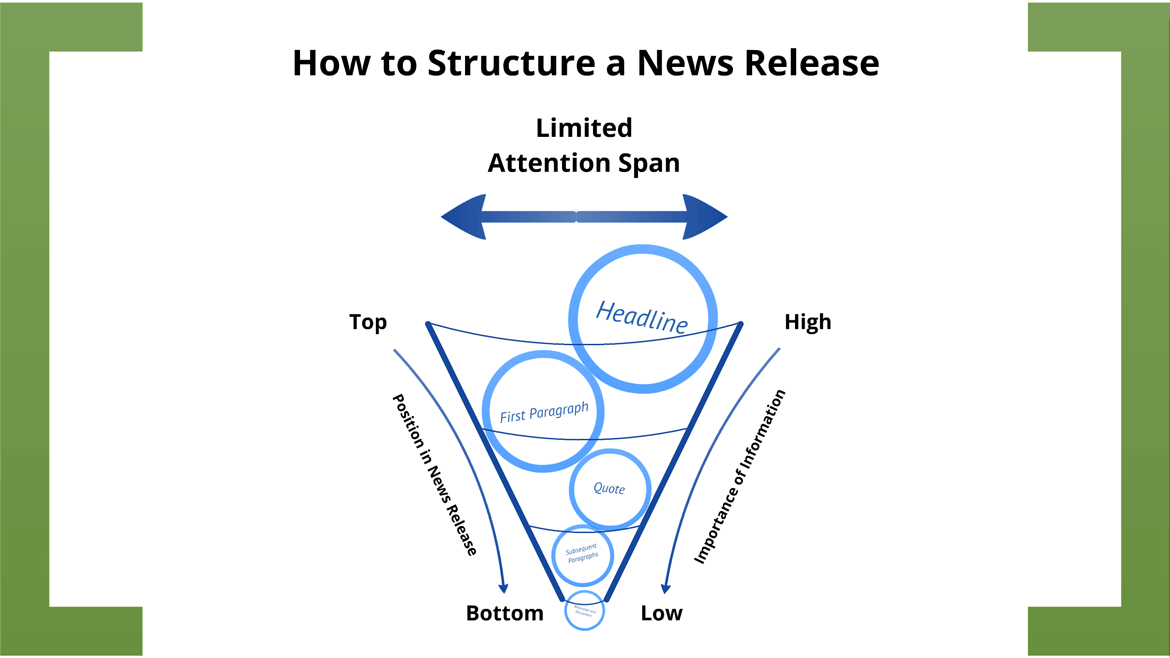A news release can generate constructive coverage or get an organization into hot water. In this article we explore how marketing and communication professionals can avoid some common traps when issuing a news release.
News Release Structure
First, put yourself into the shoes of a journalist or an analyst. You’re underpaid. You’re generally hostile towards any piece of puff cooked up by a corporate communications department. And every time you see the phrase “the Company is pleased to announce…” you grit your teeth and growl a little. Now, in this irritable state, a news release crosses your desk. Do you read:
- The entire release;
- The first paragraph; or
- Just the headline and decide what to do from there?
In your generally grouchy state you’ll probably choose the last option. The simple truth is that nobody has the time or desire to read your entire news release unless it’s newsworthy.
Common sense dictates that people have limited attention spans. If that’s true then a news release must place its most important information at the top and least important information at the bottom. Generally, the headline and first two paragraphs will determine your audience’s response to the release. That said, if you ever begin by sounding rosy and then bury a devastating piece of news in paragraph five, the market will never forgive you.

The Media’s Tips on Writing Your News Release
The Huffington Post and the Guardian have both provided useful writing tips from the perspective of a news outlet.
Grammatical Person
Generally, media outlets are more likely to cover news releases written in third person (other than the quote). This is because it is easier to cut and paste news release content into a potential news article. Writing in third person can be awkward. Audiences have a harder time reading third person. However, there is a potential solution. Many companies have adopted an ambiguous grammatical person in their results news release. By making the subject of each sentence the metric being explored, company’s can keep the news release accessible to everyone.
News Release Timing
The timing of your release will be dictated by a number of factors:
- Public company regulatory requirements;
- The audience you’re trying to reach; and
- How news is consumed.
A General Rule on Bad News
All other considerations aside, releasing bad news over a weekend or late on a Friday is frowned upon. It creates the perception that you’re trying to avoid public scrutiny and that you have something to hide. It is for this reason that you should never schedule your quarterly results release for a Friday afternoon.
If bad news takes place on a Friday afternoon there are three generally accepted options:
- If it is not a human or environmental disaster, if there is no risk of the information finding its way to the media or the public, and if you’re outside of market hours, then you should wait until Monday before markets open to release. Most examples that fall into this realm relate to inside material information that is unscheduled and undisclosed.
- If you are obligated to release due to timely disclosure laws, issue your release immediately and then re-release it on Monday morning before markets open. Also be prepared to arrange interviews over the weekend.
- In a public disaster scenario you should put out a holding statement with a scheduled follow-up in 24 hours or less. In your follow-up release include known facts that have emerged and schedule further follow-ups and press conferences as needed until the disaster has subsided. Send out a summary release before markets open on Monday about what has happened, what is known, and what remains to be determined.
Any one of these options will help prevent your public from thinking you’re hiding something.
Be Kind to Your Frontline Audience
Forcing the media and your analysts to work through their evenings and weekend will not endear you to them. They would probably prefer to see your newsworthy release at the top of their digital pile first thing in the morning. The advantage to a morning release is that your communications team is available for pro-active follow-up, you have the ability to arrange a quote, you have more opportunity to frame the news and you can address any misperceptions before the story goes to press.
Public Company Considerations
A mistake we commonly see public companies make is scheduling their results release for “after markets close.” As long as your release goes out at precisely 5:00 p.m. Eastern Time (“ET”) nobody will think twice. However, if it comes out an hour or two later, you’ve just wasted your analyst’s time. This is not how you make friends in the capital markets.
When possible, the best time to release information is before markets open (with a sufficient buffer of time so that markets can reasonably absorb the information). This is practical because it gives you plenty of time to manage edits, proofread, and go through your pre-release checklist the night before. Releasing after markets close often does not give you enough time to properly incorporate edits from your board members and senior management.
Most analysts are on calls with their sales desks at 7:00 a.m. ET, so the sell-side will appreciate it if you issue your release at 6:00 a.m. ET.
Framing Your News with a Webcast/Conference Call
Holding a webcast following a news release is a powerful way to shape the message and public perception. It also gives you a chance to address any misperceptions before they grow legs and run away on you. However, the longer you wait to hold your webcast, the less influence it will have on the story. If you release your news at 6:00 a.m. ET, then holding your conference call at the following times is both reasonable and humane:
Time Zone: Local Time: Eastern Time:
Eastern 8:00 a.m. 8:00 a.m.
Central 8:00 a.m. 9:00 a.m.
Mountain 8:00 a.m. 10:00 a.m.
Pacific 8:00 a.m. 11:00 a.m.
Go ahead, you try to convince your CEO to wake up at 4:00 a.m. in the morning to do a conference call. Then sit back and watch your CEO crash and burn because no amount of coffee will help them be articulate and eloquent.
Marketing Considerations for Public Companies
Marketing and communication professionals working for public companies should become familiar with the impact that securities regulations have on their work. Fair disclosure laws require that investors receive any information that would reasonably influence their decision to invest in a timely manner.
Things can get sticky for marketers when they make important announcements that don’t reach their company’s investor audience. For example, a company publicly listed in North America launches a new product in Europe. This product represents a significant revenue growth opportunity for the company. The company issues a news release in Europe targeting its customer base. However, the company fails to issue a news release to North American financial news outlets. The company is now in violation of securities law.
Before making a marketing announcement ask your legal team and investor relations department for guidance.
SEO Considerations
Prior 2013, using keyword links in your news release was a great way to generate Google juice. Unfortunately for SEO marketers, a change to Google’s algorithm in 2013 stripped keyword links in news releases of their SEO generation value and, some believe, actually penalized their use. (This does not apply to a direct link in the format of www.yourwebsite.com used for contact information) Almost 10 years later, this deprecated practice continues to be seen in news releases.
Distribution Killers
Legal counsel will sometimes ask that you limit the distribution of a news release to a certain region through a header that looks like the following:
“Not for distribution to [Region] news wire services or dissemination in [Region]“
This happens when companies market debt or equity securities that are prohibited from being marketed in another region. Unfortunately, this will cripple the distribution of your news release through news aggregation services such as Bloomberg, Yahoo Finance, or any other news aggregation service in the restricted region.
This means that when people go to look for your news on their favorite iPhone or Android stock app, your news release will be nowhere to be seen. Ensure your legal counsel is aware of this impact. Suggest the following disclaimer at the bottom of your release to your legal counsel instead:
“This announcement is not an offer for sale of securities nor shall it constitute an offer to sell, or the solicitation of an offer to buy, securities in any jurisdiction in which such offer, solicitation or sale would be unlawful prior to registration or qualification under the securities laws of any such jurisdiction.”
Broker-dealers can also harm distribution if they insist on issuing a news release on behalf of a Company when a deal is announced and closed. This too can wreak havoc on the distribution of the news release to your website, email alerts to your subscribers and posts to your social media profiles if your newswire is heavily integrated with your distribution processes. In addition, distribution can be withheld when the source (the broker-dealer) and the subject (your company) differ. Discuss this with your broker-dealer and insist on issuing the release through your company’s regular channels.
Don’t be a PR Dinosaur
The old teletype machines employed by news agencies continuously typed as news was wired into them. The -30- that you sometimes see at the bottom of a news release today is a remnant of that time. It was telegraph code to signal the end of the message. Today, there is no need to use -30- or ### at the end of your news release.
Conclusion
It takes more than a good writer to ensure a news release is successful. It takes good judgement and a comprehensive understanding of how various organizations and technologies engage with a news release.


